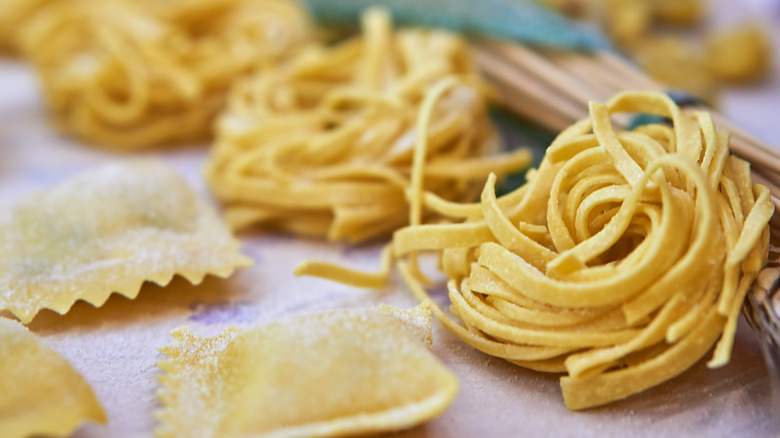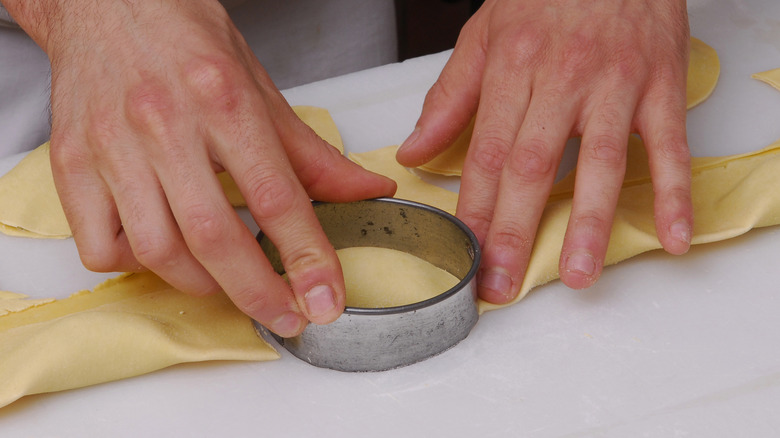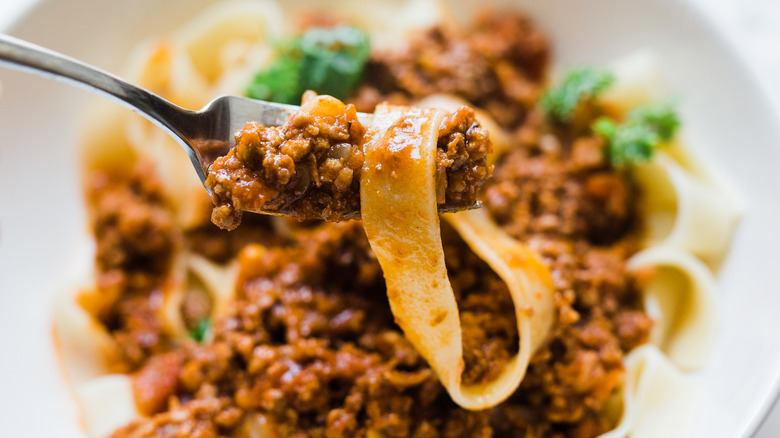The Technical Difference Between Machine And Handmade Pasta
"Making pasta" is easy when you're just cooking up dried, store-bought pasta and adding sauce, and there's nothing wrong with that. But even if you're venturing into homemade pasta with a pasta maker and homemade pasta sauce, it's still not quite the same as pasta made entirely by hand. You can notice the difference that extra effort makes in the final product. That's not a metaphorical, "love is the secret ingredient" sort of notion, either: Making pasta by hand leaves you with different noodles than machine-made pasta.
In short, rolling pasta dough with an old-fashioned rolling pin makes the pasta more textured and better at absorbing sauces. The fact that a rolling pin lacks a machine's precision actually works in its favor. Rolling by hand slowly flattens and thins out the egg dough in a way that makes it coarse, and this rough texture makes it easier for the sauce to later blend with the pasta. Meanwhile, a machine — which could be anything from a big factory machine to a manual, crank-operated pasta maker — flattens it quickly and leaves it entirely smooth.
Worth the extra effort
That texture from handmade pasta is important: Often, the difference between expensive spaghetti and cheap spaghetti is how much texture the noodles have. Cheap, mass-produced pasta looks almost unnaturally smooth, and sauce rolls off it more easily. Nearly any sauce does a better job of sticking to rough and chalky pasta. So hand-rolling can be a much cheaper way to get that sort of pasta than shelling out for the fancy stuff (although it's still not entirely the same as the fancy store-bought kind, unless you have bronze or brass pasta molds).
So, is it still worth using the machine? That depends. If you want really thin pasta, then a pasta machine will get you that more easily than hand-rolling. However, while it's easy to assume a pasta machine is always faster, it can take about the same amount of time to run dough through the machine versus rolling it with a pin. The tradeoff is that the machine will certainly be less tiring than the elbow grease required to do it the old-fashioned way. For a smaller amount of pasta, you might find rolling it by hand to be rewarding once the noodles are on your plate.
Handmade tips
If you do try putting the machinery aside and rolling up your sleeves to make pasta, there are some ways to make it slightly easier. Letting your dough sit for a little while before you roll it can help you roll it out more easily; similarly, if the dough starts returning to its old shape during rolling, that's a sign to let it sit before trying again. Pasta is just flour, eggs, olive oil, and salt, and you can make it right on your kitchen counter, so don't be afraid to mess around.
As for shapes, pappardelle is the easiest noodle because it's wide and flat. But with homemade dough, you can make round gnocchi shapes without much effort using your fingers and a fork (even if most gnocchi isn't actually pasta). Similarly, you can make seashell-shaped cavatelli pasta by just cutting up the pasta and making indents with your thumb. If you've got a wooden spoon handle, you can wrap the flat dough around it to make classic penne shapes.


